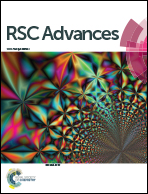Visible-light-activated photoelectrochemical biosensor for the detection of the pesticide acetochlor in vegetables and fruit based on its inhibition of glucose oxidase†
Abstract
A new and sensitive photoelectrochemical (PEC) biosensor which is visible-light-activated was fabricated based on acetochlor’s ability to inhibit glucose oxidase (GOx) activity. An NH2-MIL-125(Ti)/TiO2 nanocomposite, as a new functional material, was used for the immobilization of GOx by using chitosan (CS) as the dispersion matrix. Under visible light irradiation, the GOx/CS/NH2-MIL-125(Ti)/TiO2 nanocomposite can generate a stable photocurrent in a glucose solution. When acetochlor was added to a phosphate buffer solution containing glucose, the activity of GOx was inhibited thus causing a photocurrent drop, and the photocurrent was inversely proportional to the acetochlor concentration. A corresponding analytical method was developed. The inhibition of the photocurrent was proportional to the concentration of acetochlor in the range from 0.02 to 1.0 nM and in the range from 10 to 200 nM with a detection limit of 0.003 nM (S/N = 3). The study is a successful attempt to make a PEC biosensor based on monitoring the activity and inhibition of GOx, and shows its practical application in acetochlor detection in fruit and vegetable samples.



 Please wait while we load your content...
Please wait while we load your content...